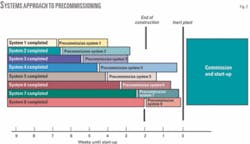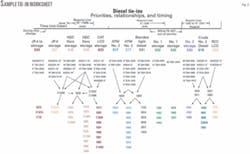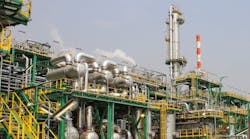The systems approach to start-up helps reduce construction man-hours by eliminating duplication of effort, which is useful in itself. It is an extension of the systems approach to construction, which involves the precommissioning team working closely with construction, beginning with the hydrotest of the systems.
The real benefit, however, is allowing customers access to the systems sooner so that they may begin to make use of them and keep their workloads more uniform during precommissioning of the project. The Construction Industry Institute (CII) is correct in stressing that the systems approach must be implemented before construction begins, so that all parties are committed to it.
The prioritization of the systems through implementation of the Precommissioning Intensity Index should be performed as early in the project as possible. Doing so can eliminate much time, money, and operator and maintenance stress.
Systems
Any particular process unit in a refinery is an assembly of many systems, each of which consists of a group of equipment with interconnecting piping and instrumentation that collectively serves to perform a specific function or purpose. This can be something as large as a complete fractionation systemsuch as a debutanizer complete with its reboiler, overhead condenser, accumulator, and all other associated exchangers, pumps and pipingor as small as the cooling-water distribution piping for its overhead condenser.
The construction industry has been building process units on a system basis for years. Now the CII has established a concept for precommissioning plants on a system basis as well.
Precommissioning is defined as all the activities required to prepare a system for commissioning and start-up such as punch listing, cleaning, flushing, loading of packing and catalyst, and final assembly and closure of equipment. With proper controls, air freeing or inerting of equipment could be included as part of the precommissioning phase.
Commissioning is defined as actually putting those systems into service. If the equipment in a system was not inerted at the end of the precommissioning phase, it definitely must be at the beginning of the commissioning phase before normal operating fluids (hydrocarbons, for instance) could be brought in.
Constructing by systems
A system consists of a group of equipment with interconnecting piping and instrumentation that collectively serves to perform a specific function or purpose.
Because of this common purpose, all of the piping in a system is usually fabricated from the same line class. That defines the pressure rating, metallurgy, and any need for postweld heat treating of piping in the system. That is why construction has been using the systems approach for some time now.
It makes sense to group the piping together for a common hydrotest if there is an entire sequence of equipment at the same pressure rating. If it happens to be fabricated from stainless steel or high-chrome carbon steel, then either water with low levels of chloride or postweld heat treatment would also be required. There are therefore many practical reasons for construction to build units on a system basis.
There are also many other practical reasons from an operations standpoint for precommissioning purposes to build units on a system basis. Once a system has been successfully hydrotested by construction, the precommissioning phase may begin. This involves flushing lines to clean them and remove debris.
Once that is done and the system reassembled, functional testing of equipment can be performed. This includes, but is not limited to, such tasks as bumping and running motors and steam drivers, setting overspeed trips, cold alignment of pumps, stroking control valves, and performing loop checks.
Precommissioning systems
In the past, it was not uncommon for the contractor to complete the entire plant before any precommissioning work began (Fig. 1). The new method, which CII fosters, is to begin precommissioning of a system once construction has finished hydrotesting it. This also allows the customer to make use of each system much sooner.
Use does not necessarily mean putting the system into commission or operation. But it does mean all of those things up to that point, such as operator familiarization with the system or spreading out the workload on the customer’s personnel to a more manageable level.
That could allow the customer to have the entire plant inerted just a few days after the last system is turned over and possibly commissioned and up and running a few days after that.
This takes a great deal of coordination between construction and operations, but it can work to the benefit of both. For instance, it is common for the contractor to remove equipment and pressure-sensitive instrumentation from a system for the hydrotest. Then the whole system must be reassembled (reinstating) after the hydrotest.
This was necessary before the customer would accept or buy the plant. Then much of this equipment would be removed again for flushing and cleaning, and subsequently reinstalled.
Now with proper coordination, the flushing and cleaning portion of the precommissioning phase occurs directly before or after the hydrotest, often with the same water or fluid. This is particularly true if a special water or fluid for metallurgical or freezing considerations must be used for the hydrotest.
Then system equipment can be reinstated for the first and only time, which saves having to handle the equipment several times. This also minimizes the precommissioning manpower requirements for the customer.
Because the contractor cannot possibly hydrotest all systems at the same time, the customer will not have to perform the precommissioning on all of the systems at the same time either.
Instead, system precommissioning can be handled in a phased approach by turning the systems over to the plant owner one at a time, so that the owner’s workforce will only be dealing with one or two systems at any given time (Fig. 2). This is important because the owner will not have the same manpower resources that the contractor can have.
Instead of having to work a lot of overtime, the owner can work on the systems in an orderly manner, which also facilitates operator training. Start-ups will also be smoother because the operators are not tired and stressed from long periods of overtime.
The benefit to the contractor for this is a longer construction time frame. Instead of having to complete construction typically 6 weeks or more before start-up, end of construction on the last few systems can be as late as a couple of weeks before start-up. Average end of construction is therefore only 2-3 weeks before start-up, which gives construction 3-4 more weeks to work.
This does require making some of the utility systems “hot” during construction, which requires extra safety precautions and vigilance. Although use by the owner does not mean commissioning of systems, there are some exceptions.
Typically those are steam, condensate, instrument air, and electrical powerutilities that are required for functional testing of the equipment. All of these are hazardous because of their high energy potential. But steam is the most onerous because it can also cause severe burns. Insulation on it must therefore be complete before it can be put into service.
A prime example of this occurred in the fall and winter of 1977 when I was the project manager for what was then Plateau, Inc., for the relocation of an fluid catalytic cracking unit from Winnipeg, Man., to Bloomfield, NM. Due to the death of the original field superintendent followed by a series of failed attempts at replacements, the construction force had essentially no direction and was confused about what to do next.
At this point I divided the main column and gas concentration unit into systems so that construction workers could focus on one section at a time. The depropanizer and propane-drying column was one section, the debutanizer was the next section, the recovery section was the third, and the main column with all of its pumparounds was the fourth section.
We started with the depropanizer. As soon as it was complete, the operators performed the hydrotest and flushing with that system’s pumps and worked forward through the plant to the debutanizer, followed by the recovery section and then the main column.
By this point, I had assumed the position of acting field superintendent for the contractor as well, and was developing priorities and work lists for each section. This unique situation allowed the required coordination to make this approach work.
Another unique facet of this project was that we operated the main column and gas concentration unit as a crude unit for 16 weeks while the regular crude unit was being revamped to produce the required feed for the FCC. I did not realize it at the time, but this allowed me to make use of operations and maintenance staffs.
By the time the crude unit was back on line and the FCC reactor structure was complete, we had all of the bugs worked out of the downstream portion of the FCC, and the operators were very familiar with its operation.
Although this was an extreme case of making use of systems, it is the epitome of what it means. When we pulled the blind on the reactor vapor line to start feed to the riser, we only had to worry about and concentrate on the operator’s first-time exposure to circulating catalyst and operating an FCC reactor and regenerator.
Optimize the schedule
Although it is easy to see graphically that the new method promoted by CII makes a lot of sense, there is really much more to it. Just completing the systems in a phased approach still does not optimize the completion of the construction and precommissioning phases of the project.
Proper optimization will determine which systems should be completed first and which ones can be completed last. Because some systems are much more complex than others, it is simply practical to complete and precommission them first, to keep them from becoming critical.
Fig. 2 shows this. Precommissioning requirements and time involved on some complex systems will take longer than on simple systems. Some systems might be more important than others, and they too should be completed earlier rather than later.
On some large projects there will undoubtedly be many complex systems. In that case, it is practical to intersperse them among some simpler systems so that operations does not have to deal with too many complex systems at the same time, and it helps to smooth the customer’s workforce.
During the winter 1999-2000, myself, a team of three other process engineers, and a score of pipe designers was charged with designing 350 tie-ins in the off site areas required for the start-up of a large refinery expansion on the Canadian East Coast. These were for the new feed and product lines between the new units and the existing tanks and for new lines and manifolds in the gasoline and diesel product blending systems.
Through careful evaluation and systemization of the lines and their tie-ins, we developed a strategy to implement the tie-ins in both product-blending areas without any effect on their day-to-day blending operations.
Fig. 3 shows an example of the worksheet used.
The systems are prioritized from left to right. Critical tie-ins for each system are in the center of the figure. Once we established those tie-ins, that whole system could be isolated to install the rest of its tie-ins. In this manner, only one blending pump was taken out of service at any time. Because each pump was manifolded with at least one other pump, it was possible to work systematically through the systems without interfering with the blending operation.
This was a successful effort to prioritize and manage the work to the benefit of the refiner, which up until then was concerned with the potential for any loss of blending time. It is a good example of the use of systems for this purpose.
Precommissioning Intensity
The final element required to make the system approach workable is to set the priorities of which systems are required first and which can be last. The precommissioning intensity index (PCII) was specifically developed for this purpose.
Through a critical examination of all of the systems, the proper sequence for completing them should ideally develop before construction. Tracing and insulation are also time-consuming activities; therefore, emphasis is also placed on completing those systems before others. That also clears the unit of scaffolding sooner, which reduces the safety risk during the later precommissioning and subsequent commissioning efforts.
To develop the PCII properly and to prioritize the systems-completion sequence require someone knowledgeable and experienced to know what is really going to happen during precommissioning. Someone who can minimize the critical path and can keep the precommissioning path simple is needed.
Table 1 is an example of an abbreviated spreadsheet for determining the PCII of some systems.
For example, it is often incorrectly assumed that all of the utilities must be precommissioned first. In reality, many of them do not. Plant water, plant air, fuel gas, nitrogen, flare, and possibly many others depending on the plant are simple systems that can wait until the last minute for completion and precommissioning.
Some would argue that those systems are needed for precommissioning the process systems, but that is not always true. If a lot of water is needed, for example, the process water system will not do much good. In reality, the fire water system can be used.
I have cured many refractory liners with outside heat-treating contractors without using the unit’s fuel-gas system. The cure has always been much better than operations could have done because it can apply the heat much more uniformly. This might also change the timing and priority for any system that requires refractory curing and avoids making them part of the critical path.
For example, during summer 2000, I helped relocate and recommission an FCC reactor regenerator structure. I recommended that the refiner use Cooperheat to cure the new refractory liner in the regenerator and the other refractory patches in the riser and reactor.
We had a natural gas source in a nearby unit and installed a temporary 2-in. line from it to Cooperheat’s control station. Cooperheat performed the cure during a holiday weekend, when no construction workers were in the plant, and executed a superb cure.
The vendor did this without having to completely head up any of the vessels. This completely removed the cure and all of the systems required for it from the critical path and streamlined the first start-up immensely.
In retrospect, this turned out to be an expedient decision because the air blower’s start-up was delayed a few days due to electrical switchgear problems. If the refractory cure had still been ahead of us, the refiner’s patience would have snapped. Because of our decision, however, we did not have to perform the cure or the always debatably and time-consuming postcure unheading for refractory inspection. Once we had the air blower in operation, it was full steam ahead.
Tripping hazards
Although there are successes with the systems approach to start-ups, there are also difficulties. Even though the benefits for its use are obvious, there are a few things that can still trip it up.
Plant owners must beware of:
- The contractor’s field supervisors. Even though the contractor’s general managers might have bought into the program wholeheartedly from the beginning, many times their field supervisors have not. It takes much effort and determination to keep it going. Because they are charged with showing progress with good productivity, they will be hesitant to try something new. They would prefer to gang a whole geographic area of the plant to minimize their resources before relocating those resources to move onto the next section.
What really happens in the field, therefore, is to construct the plant in whole blocks until about 70% completion, and then move to systems. It is at this point that the issue must be emphasized. - The engineering group. The owner and contractor can agree on the systems approach, but the contractor will be unable to implement it if the detailed engineering is incomplete. This can be a problem with fast-tracked jobs. This may mean the owner must be flexible and willing to do some trading between systems to accomplish the end result.
- Equipment vendors and process licensors. Everything can be going perfectly until vendors and licensors show up, because when they do, they want to punch out everything that has to do with their equipment or process. That can confuse and demoralize contractors, because they can begin receiving punch lists for systems that have not yet been completed or turned over.
The owner can be taking a lot of care with the contractor and then have the whole thing blow up over this. The owner must act as a filter between them and the contractor. - Instrument and electrical technicians. Of all of the maintenance crafts, this one presents the greatest obstacle. Instrument technicians are resistant to performing individual system loop and continuity checks on a daily basis. They would rather wait until the end of the week, and then do them all. It takes a strong maintenance supervisor to overcome this inertia.
The author
James D. Weith ([email protected]) is the principal of Practical Enginuity, Peoria, Ariz., a company he formed in 2001. Weith has also worked as a process and project engineer at UOP LLC, a process-project engineer at Plateau Inc., a consulting refinery engineer at Unocal Inc., principal engineer at Fluor Daniel Inc., and a process engineer at Mustang Engineers & Constructors LP. He holds a BS in chemical engineering from the University of Colorado and an MBA and MSBA in management and organization from the University of Southern California. Weith is a member of AIChE and is a registered professional engineer in Colorado.







